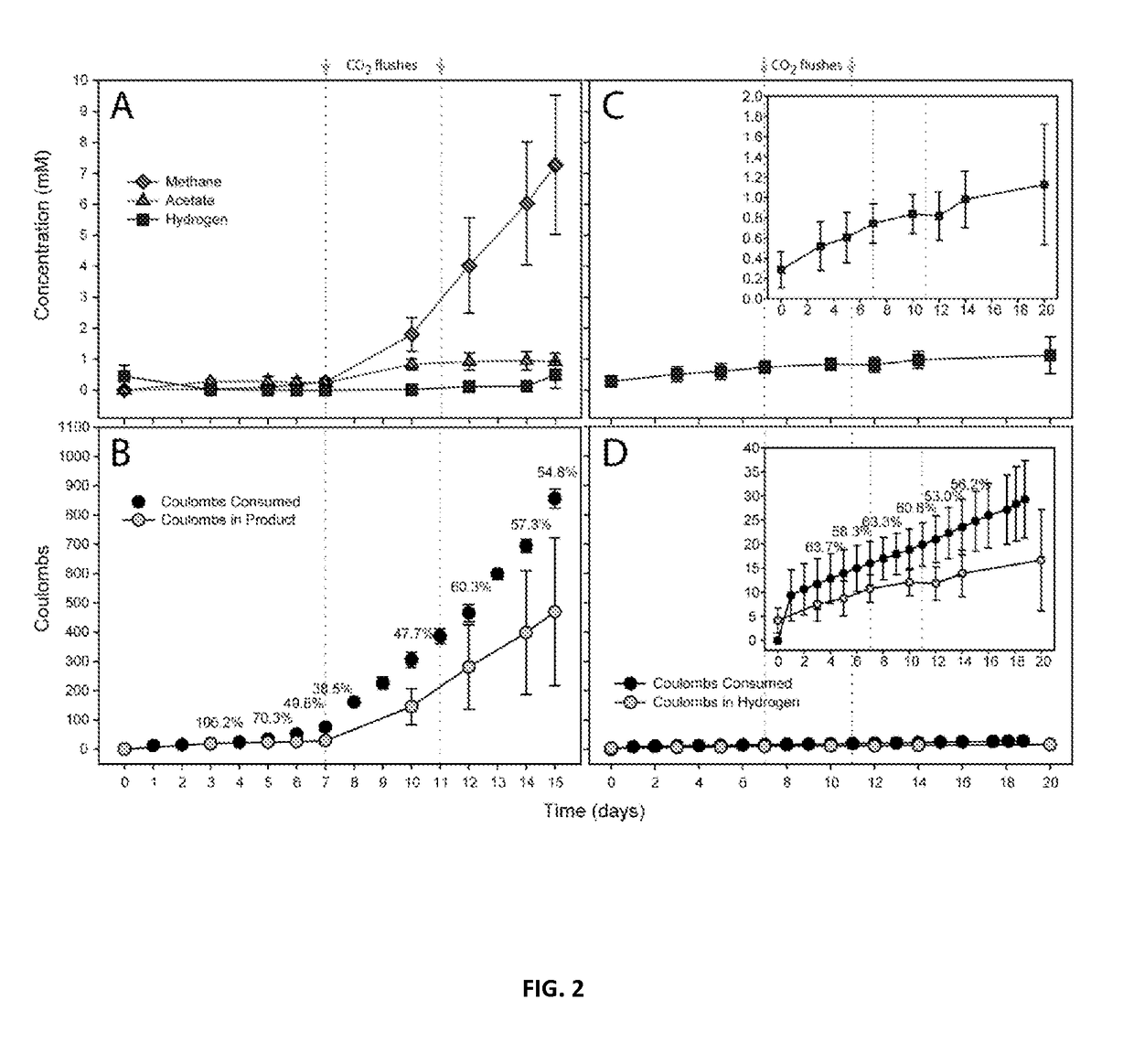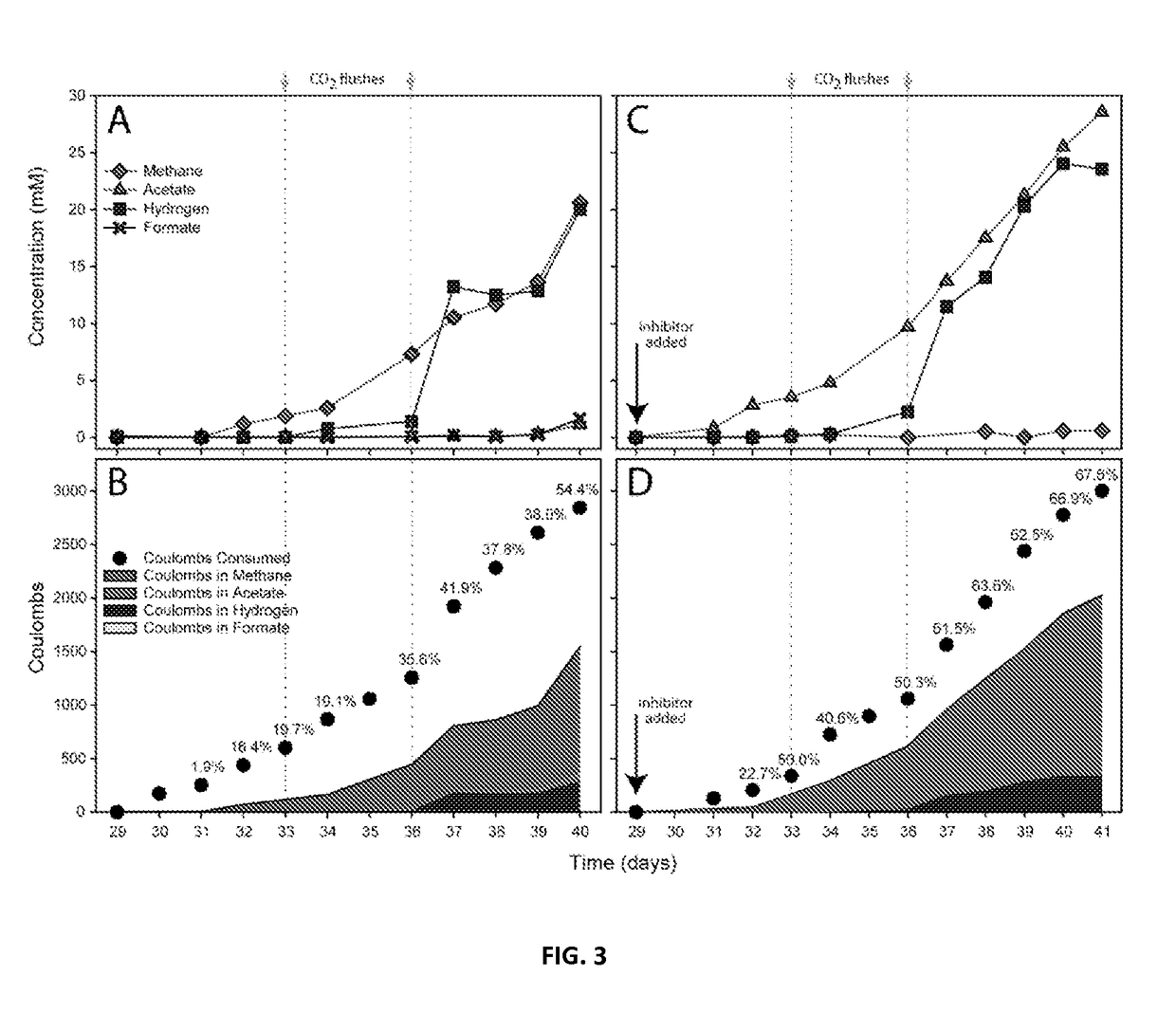Microbial electrosynthetic cells
a technology of electrosynthetic cells and microorganisms, applied in the field of microorganism electrosynthetic cells, can solve the problems of inability to demonstrate the efficiency of microbial conversion of cosub>2/sub>into usable commodity chemicals, organics, bioplastics, etc., and most of these energy sources are either limited or not sufficien
- Summary
- Abstract
- Description
- Claims
- Application Information
AI Technical Summary
Benefits of technology
Problems solved by technology
Method used
Image
Examples
example 1
and Methods of the Studies
Source of Microorganisms and Initial Screening
[0074]The biocatalysts described here were enriched from samples taken from a retention basin for brewery wastewater at Palmetto Brewing Company in Charleston, S.C. To screen for initial product formation, the brewery wastewater sludge was used to inoculate 20 ml chambers of small BES reactors equipped with graphite rod cathodes. Reactors were poised from −1000 to −400 mV vs. SHE with the goal of selecting for the highest rate of product formation at the highest potential to limit energy input into the system. Products (acetate and methane) were detected after 28 days of incubation at −590 mV and again after the medium had been exchanged once. Controls without voltage applied were monitored for production due to fermentation of the wastewater. Once production free of fermentation was indicated, inoculum from these reactors was then transferred to larger 3-electrode BES reactors described below in order to furthe...
example 2
f the Initial Culture Studies
Establishing an Autotrophic Biocathode
[0086]A 3-electrode BES (FIG. 14) was inoculated from a brewery waste culture that was initially screened in a small 2-electrode BES. The 3-electrode BES was operated for three months at a fixed cathode potential of −590 mV. The electrode was the microbial community's only electron donor and CO2 its only carbon source for growth throughout all experiments. During the first 10 days of incubation, the reactor generated 1.8 mM acetate followed by 2.6 mM of methane over 30 days as the main products from CO2 fixation before the first exchange of the spent growth medium (FIG. 1A). Production rates reached 0.18 mmoles acetate per liter of cathode liquid volume per day (mM day−1) and 0.12 mM day−1 methane during this initial startup. Subsequently after successive medium exchanges, methanogenesis became the dominant process and reached 0.78 mM day−1.
[0087]As CO2 was consumed and reduced to methane, the pH in the cathode chamb...
example 3
Culture Studies
Materials and Methods
[0123]Source of Microorganisms and Bioelectrochemical Setup
[0124]Graphite granules and supernatant from the initial microbial electrosynthesis system described by in Examples 1-2 were used as inoculum for the MESs described in Example 3. The original source of microorganisms was from a wastewater basin at Palmetto Brewing Company in Charleston, S.C.
[0125]The reactor design, materials, and medium composition were exactly as described in Examples 1-2. Briefly, two identical custom glass chambers were clamped together with a Nafion 117 proton exchange membrane separating the two chambers (see e.g., FIG. 14). The total volume of each glass chamber was 150 mL. A graphite rod current collector connected to a titanium wire was buried under 30 g of graphite granules (Showa Denko) and connected to a VMP3 (Biologic) potentiostat in both the working (cathode) and counter (anode) electrode compartments. The cathode chamber was filled with 75 mL of freshwater ...
PUM
| Property | Measurement | Unit |
|---|---|---|
| cathode voltage potential | aaaaa | aaaaa |
| cathode voltage potential | aaaaa | aaaaa |
| cathode voltage potential | aaaaa | aaaaa |
Abstract
Description
Claims
Application Information
 Login to View More
Login to View More - R&D
- Intellectual Property
- Life Sciences
- Materials
- Tech Scout
- Unparalleled Data Quality
- Higher Quality Content
- 60% Fewer Hallucinations
Browse by: Latest US Patents, China's latest patents, Technical Efficacy Thesaurus, Application Domain, Technology Topic, Popular Technical Reports.
© 2025 PatSnap. All rights reserved.Legal|Privacy policy|Modern Slavery Act Transparency Statement|Sitemap|About US| Contact US: help@patsnap.com



